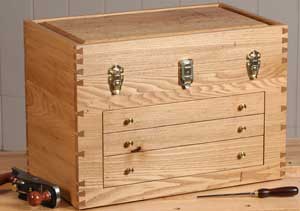
I’ve checked my library of woodworking books and I learned that oak contains chemicals that may promote rusting. But, Gerstner (machinist) toolboxes were made of oak — maybe Gerstner’s oak is/was different. We live in a humid environment (Pennsylvania). Is there a “correct” wood species for making a toolbox? Also, should I avoid using certain kinds of glue, such as PVA? Can I use plywood for the panels? – Paul Fallert
Tim Inman: Oak does indeed contain tannic acid and will promote rusting and staining of tools (and wood) if they are in direct contact with unfinished oak wood. Most toolbox interiors are finished or oiled, and the bottoms of the drawers are lined with baize. That said, any wood could work. A “rough” toolbox is usually made from lower priced woods. A really nice box would be better made from select hardwoods. If you’re going to spend the time to build a really nice chest, use the best woods available. Plywood is very stable dimensionally, so it makes great panels. Use your favorite adhesives. Once cured, I don’t know of any reason one would be better for a toolchest than another. Select the best glue for the need at hand. I collect antique boxes. Many toolchests were apprentice samplers. You’ll find different woods, different cuts, different joints used in them; veneers, inlays, handmade brasses – everything the master could teach. Good, dry wood well-finished should eliminate your staining and rusting concerns. Have some fun, and send us a picture when you’re finished!
Chris Marshall: I agree with Tim – if you seal your tool chest with a film finish such as lacquer, varnish or shellac, go ahead and use any dry wood that you’d otherwise choose to build furniture. Pick something nice, and that chest just may become a family heirloom as well as a hardworking part of your shop.







